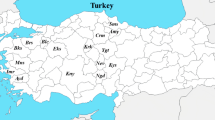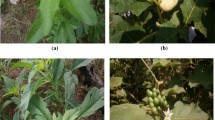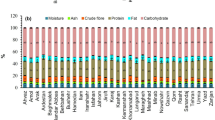Abstract
Montia fontana L. is an aquatic plant traditionally consumed in the Centre and West of the Iberian Peninsula, where it is one of the most highly valued wild vegetables. The aim of this work was to evaluate both the natural yield and nutritional value of this scarcely known plant. Two wild populations, from two different sites of Central Spain, were sampled during three consecutive years. Plant production was estimated by two parameters: production per unit of surface and plant percentage cover in the selected site. Nutritional analyses included proximate composition and total energy, mineral macro and microelements, vitamin C, and organic acids. Mean yield at the growing areas was 2.64 kg/m2, though significant differences among sites and years were found. There was a positive correlation between production and accumulated rainfall from the beginning of the year till the collecting dates. The percentage cover of the species in the potential growing area was 8.25%, without significant differences among sites and years. Therefore, the wild populations of the species can reach a total mean production of 2,138 kg/ha in this Spanish region. This is the first report of a global nutrient composition for Montia fontana. After moisture, the major constituent was fibre (4.44%), much higher than many cultivated vegetables. Also appreciable amounts of vitamin C (34 mg/100 g) and Mn (1.07 mg/100 g) were found. Due to its high lipid content (1.94%) this wild vegetable could be regarded as one of the richest source of omega-3 fatty acids among the leafy vegetables. This species can be considered an interesting wild resource for being included in the diet. Further research is needed for addressing its potential for being cultivated under different culture systems and for selecting accessions with lower oxalate content.



Similar content being viewed by others
References
Aceituno-Mata L (2010) Estudio etnobotánico y agroecológico de la Sierra Norte de Madrid. PhD thesis. Universidad Autónoma de Madrid. Available at http://digitool-uam.greendata.es
ADISAC (2006) Los guardianes de las semillas. ADISAC-La Voz, Zamora
Allen DE, Hatfield G (2004) Medicinal plants in folk tradition. An Ethnobotany of Britain & Ireland. Timber Press, Cambridge
Alves Ribeiro J, Monteiro AM, Fonseca da Silva ML (2000) Etnobotânica. In: Joâo Azevedo (ed) Plantas bravias, comestíveis, condimentares e medicinais. Mirandela
AOAC (2006) Official methods of analysis, 18th edn. AOAC International, Arlington Virginia
Blanco E (1998) Diccionario de etnobotánica segoviana. Ayuntamiento de Segovia, Segovia
Blanco E, Cuadrado C (2000) Etnobotánica en Extremadura. Estudio de La Calabria y La Siberia extremeñas. Emilio Blanco y CEP Alcoba de los Montes, Madrid
Carvalho AM (2010) Plantas y sabiduría popular del Parque Natural de Montesinho. Un estudio etnobotánico en Portugal. CSIC, Madrid
Chai W, Liebman M (2005) Effect of different cooking methods on vegetable oxalate content. J Agric Food Chem 53:3027–3030
Concon JM (1988) Toxicology: principles and concepts. Marcel Dekker, New York
Couplan F (1989) Le regal vegetal. Plantes sauvages comestibles. Encyclopedie des plantes comestibles de l’Europe, vol 1. Equilibres Aujourd’houi, Flers
Criado J, Fernández López JM, Leocadio G, Núñez RM, Blanco E (2008) Uso tradicional de las plantas en Toledo. Diputación de Toledo, Toledo
Díaz-Fernández PM, Ramos Miras JJ, San José A, Pascual Gallego V, López-Almansa JC, Muñoz-Gallego CL (2008) Puesta en valor de recursos genéticos vegetales y su aplicación a estrategias de desarrollo rural. Estudio etnobotánico de Montia fontana L. en la provincia de Ávila. CONAMA 9. Congreso Nacional de Medio Ambiente
EFSA Panel on Dietetic Products, Nutrition, Allergies (2010) Scientific opinion on dietary reference values for carbohydrates and dietary fibre. EFSA J 8(3):1462
Fennell JFM (2006) Potential for watercress production in Australia. Rural Industries Research and Development Corporation, Kingston ACT, Australia
Flyman MV, Afolayan AJ (2006) The sustainability of wild vegetables for alleviating human dietary deficiencies. S Afr J Bot 72:492–497
Fontana E, Hoeberechts J, Nicola S, Cros V, Palmegiano GB, Peiretti PG (2006) Nitrogen concentration and nitrate/ammonium ratio affect yield and change the oxalic acid concentration and fatty acid profile of purslane (Portulaca oleracea L.) grown in a soilless culture system. J Sci Food Agric 86(14):2417–2424
González JA, García-Barriuso M, Amich F (2010) The consumption of wild and semi-domesticated edible plants in the Arribes del Duero (Salamanca-Zamora, Spain): an analysis of traditional knowledge. Genet Resour Crop Evol doi:10.1007/s10722-010-9635-8
Grivetti LE, Ogle BM (2000) Value of traditional foods in meeting macro- and micronutrient needs: the wild plant connection. Nutr Res Rev 13:31–46
Guiberteau A (1990) El berro: características y cultivo. Junta de Extremadura, Mérida
Guil-Guerrero JL, Rodríguez-Garcia I, Torija-Isasa ME (1997) Nutritional and toxic factors in selected wild edible plants. Plant Foods Hum Nutr 51(2):99–107
Gupta S, Lakshmi AJ, Manjunath MN, Prakash J (2005) Analysis of nutrient and antinutrient content of underutilized green leafy vegetables. Lwt-Food Sci Technol 38(4):339–345
Hammer K (2001) Portulacaceae. In: Hanelt P, Institute of Plant Genetics and Crop Plant Research (eds) Mansfeld’s encyclopedia of agricultural and horticultural crops. Springer-Verlag, Berlin, Heidelberg, New York., pp 223–227
Jage H (1979) Portulacaceae. In: Conert HJ, Schultze-Motel W, Wagenitz G (eds) Gustav Hegi Illustrierte Flora von Mitteleuropa. Paul Parey, Berlin-Hamburg, pp 1183–1221
Kerns BK, Alexander SJ, Bailey JD (2004) Huckleberry abundance, stand conditions, and use in Western Oregon: evaluating the role of forest management. Econ Bot 58(4):668–678
Lasheras C, Fernandez S, Patterson AM (2000) Mediterranean diet and age with respect to overall survival in institutionalized, nonsmoking elderly people. Am J Clin Nut 71(4):987–992
López-Bucio J, Nieto-Jacobo MF, Ramírez-Rodríguez V, Herrera-Estrella L (2000) Organic acid metabolism in plants: from adaptive physiology to transgenic varieties for cultivation in extreme soils. Plant Sci 160:1–13
Massey LK (2007) Food oxalate: factors affecting measurement, biological variation, and bioavailability. J Am Diet Assoc 107(7):1191–1194
McDermott JH (2000) Antioxidant nutrients: current dietary recommendations and research update. J A Pharm Assoc 40(6):785–799
Miinaa J, Pukkalab T, Hotanena JP, Saloa K (2010) Optimizing the joint production of timber and bilberries. Forest Ecol Manag 259:2065–2071
Moerman DE (1998) Native American Ethnobotany. Timber Press, Portland and Cambrige
Molina M, Pardo-de-Santayana M, Aceituno L, Morales R, Tardío J (2011) Fruit production of Strawberry-tree (Arbutus unedo L.) in two Spanish forests. Forestry doi:10.1093/forestry/cpr031
Morales P, Carvalho AM, Sánchez-Mata MC, Cámara M, Molina M, Ferreira ICFR (2011a) Tocopherol composition and antioxidant activity of Spanish wild vegetables. Genet Resour Crop Evol doi:10.1007/s10722-011-9726-1
Morales P, Ferreira ICFR, Carvalho AM, Sánchez-Mata MC, Cámara M, Tardío J (2011b) Fatty acids characterization of twenty Spanish wild vegetables. Food Sci Technol Int (In Press)
Munro DB, Small E (1997) Vegetables of Canada. National Research Council of Canada, Ottawa
Murray G, Boxall PC, Wein RW (2005) Distribution, abundance, and utilization of wild berries by the Gwich’in people in the Mackenzie River Delta Region. Econ Bot 59(2):174–184
Nakata PA (2003) Advances in our understanding of calcium oxalate crystal formation and function in plants. Plant Sci 164(6):901–909
Naudé TW, Naidoo V (2007) Oxalates-containing plants. In: Gupta RC (ed) Veterinary toxicology. Academic Press, New York, pp 880–891
Ogle BM (2001) Wild vegetables and micronutrient nutrition. studies on the significance of wild vegetables in women’s diets in Vietnam. PhD thesis. Uppsala University, Uppsala
Oliveira AP, Pereira JA, Andrade PB, Valentão P, Seabra RM, Silva BM (2008) Organic acids composition of Cydonia oblonga Miller leaf. Food Chem 111:393–399
Osborne DR, Voogt P (1986) Análisis de los nutrientes de los alimentos. Ed. Acribia, S.A, Zaragoza
Paiva J, Villanueva E (1990) Montia L. In: Castroviejo S, Laínz M, López González G, Montserrat P, Muñoz Garmendia F, Paiva J, Villar L (eds) Flora Iberica, vol 1. CSIC, Madrid, pp 469–473
Paiva J, Cirujano S, Villanueva E (1986) Montia fontana L. (Portulacaceae) en la Península Ibérica. Bol Soc Brot, Sér 2, 59:321–333
Palaniswamy UR, Bible BB, McAvoy RJ (2002) Effect of nitrate:ammonium nitrogen ratio on oxalate levels of purslane. In: Janick J, Whipkey A (eds) Trends in new crops and new uses. ASHS Press, Alexandria, pp 453–455
Pardo de Santayana M, Tardío J, Blanco E, Carvalho AM, Lastra JJ, San Miguel E, Morales R (2007) Traditional knowledge on wild edible plants in the northwest of the Iberian Peninsula (Spain and Portugal): a comparative study. J Ethnobiol Ethnomed 3:27
PFAF (2011) Plants for a Future: edible, medicinal and useful plants for a healthier world. Database, available at http://www.pfaf.org. (Last accessed 13 April 2011)
Phillips KM, Tarragó-Trani MT, Gebhardt SE, Exler J, Patterson KY, Haytowitz DB, Pehrsson PR, Holden JM (2010) Stability of vitamin C in frozen raw fruit and vegetable homogenates. J Food Compos Anal 23:253–259
Sánchez-Mata MC, Cabrera-Loera RD, Morales P, Fernández-Ruiz V, Cámara M, Díez-Marqués C, Pardo-de-Santayana M, Tardío J (2011) Wild vegetables of the Mediterranean area as valuable sources of bioactive compounds. Genet Resour Crop Evol doi:10.1007/s10722-011-9693-6
Sánchez-Monge E (2001) Diccionario de plantas de interés agrícola. Ministerio de Agricultura, Pesca y Alimentación, Madrid
Schaffer S, Schmitt-Schillig S, Müller WE, Eckert GP (2005) Antioxidant properties of mediterranean food plants extracts: geographical differences. J Physiol Pharmacol 56(Suppl. 1):115–124
Schelstraete M, Kennedy BM (1980) Composition of miner′s lettuce (Montia perfoliata). J Am Diet Assoc 77(1):21–25
Schippers RR (2004) Nasturtium officinale. In: Grubben GJH, Denton OA (eds) Plant resources of tropical Africa 2. Vegetables. Prota Foundation-Backhuys Publishers-CTA, Wageningem, pp 401–403
Simopoulos AP (2003) Importance of the ratio of omega-6/omega-3 essential fatty-acids: evolutionary aspects. In: Simopoulos AP, Cleland LG (eds) Omega-6/omega-3 essential fatty-acids: the scientific evidence. Karger, Basel, pp 1–22
Simopoulos AP (2004) Omega-3 fatty acids and antioxidants in edible wild plants. Biol Res 37:263–277
Smith EN (2007) Watercress (Nasturtium officinale) production utilizing brook trout (Salvelinus fontinalis) flow-through aquaculture effluent. Davis College of Agriculture, Forestry, and Consumer Sciences at West Virginia University
Souci SW, Fachmann W, Kraut H (2008) Food composition and nutrition tables. Medpharm Scientific Publishers, Stuttgart
Tardío J, Pascual H, Morales R (2002) Alimentos silvestres de Madrid. Guía de plantas y setas de uso alimentario tradicional en la Comunidad de Madrid. Ediciones La Librería, Madrid
Tardío J, Pascual H, Morales R (2005) Wild food plants traditionally used in the province of Madrid. Econ Bot 59(2):122–136
Tardío J, Pardo de Santayana M, Morales R (2006) Ethnobotanical review of wild edible plants in Spain. Bot J Linn Soc 152(1):27–72
Trumbo P, Schlicker S, Yates AA, Poos M (2002) Dietary reference intakes for energy, carbohydrate, fiber, fat, fatty acids, cholesterol, protein and amino acids. J Am Diet Assoc 102:1621–1630
Umar KJ, Hassan LG, Dangoggo SM, Ladan MJ (2007) Nutritional composition of water spinach (Ipomoea aquatica Forsk.) leaves. J Appl Sci 7(6):803–809
Uusiku NP, Oelofse A, Duodu KG, Bester MJ, Faber M (2010) Nutritional value of leafy vegetables of sub-Saharan Africa and their potential contribution to human health: a review. J Food Compos Anal 23(6):499–509
Vardavas CI, Majchrzak D, Wagner KH, Elmadfa I, Katafos A (2006) The antioxidant and phylloquinone content of wildly grown greens in Crete. Food Chem 99(4):813–821
Velasco JM, Criado J, Blanco E (2010) Usos tradicionales de las plantas en la provincia de Salamanca. Diputación de Salamanca, Salamanca
Walters SM (1964) Montia L. In: Tutin TG, Heywood VH, Burges DM, Moore DH, Valentine SM, Walters SM, Webb DA (eds) Flora Europaea, vol 1. The University Press, Cambridge and London, pp 114–115
Youngblood D (2004) Identification and quantification of edible plant foods in the upper (Nama) Karoo, South Africa. Econ Bot 58:43–65
Acknowledgments
Research funding was obtained from ERDF and the Spanish Ministry of Education and Science (CGL2006-09546/BOS). María Molina and Patricia García-Herrera were granted by predoctoral fellowships provided by IMIDRA and Universidad Complutense de Madrid, respectively. We want to thank to Susana González for collaborating in the field work and to Carmen Diez Marqués, for her support in mineral elements analysis.
Author information
Authors and Affiliations
Corresponding author
Rights and permissions
About this article
Cite this article
Tardío, J., Molina, M., Aceituno-Mata, L. et al. Montia fontana L. (Portulacaceae), an interesting wild vegetable traditionally consumed in the Iberian Peninsula. Genet Resour Crop Evol 58, 1105–1118 (2011). https://doi.org/10.1007/s10722-011-9749-7
Received:
Accepted:
Published:
Issue Date:
DOI: https://doi.org/10.1007/s10722-011-9749-7




